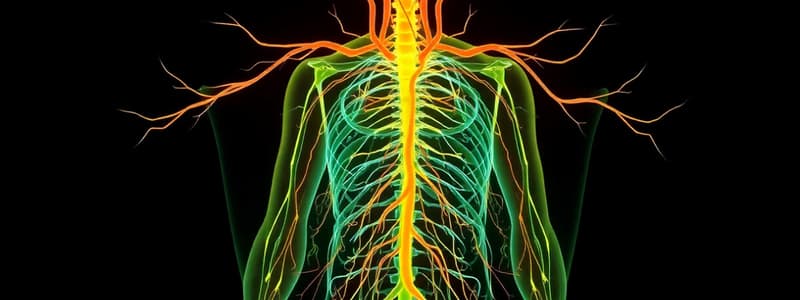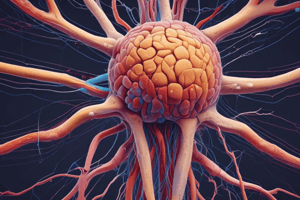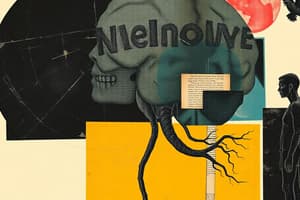Podcast
Questions and Answers
What is the main role of preganglionic fibers that extend to the adrenal medulla?
What is the main role of preganglionic fibers that extend to the adrenal medulla?
- Stimulate secretion of epinephrine and norepinephrine (correct)
- Control muscle contractions in the abdomen
- Supply blood to the adrenal glands
- Inhibit secretion of hormones
Which cranial nerve is primarily responsible for supplying parasympathetic fibers to the body?
Which cranial nerve is primarily responsible for supplying parasympathetic fibers to the body?
- Cranial nerve V
- Cranial nerve X (correct)
- Cranial nerve VII
- Cranial nerve III
What type of receptor binds acetylcholine in target organs of the parasympathetic system?
What type of receptor binds acetylcholine in target organs of the parasympathetic system?
- Muscarinic receptors (correct)
- Adrenergic receptors
- G-protein coupled receptors
- Nicotinic receptors
Which of the following effects does the sympathetic system have on the urinary bladder?
Which of the following effects does the sympathetic system have on the urinary bladder?
Which adrenergic receptor type is primarily associated with increasing the heart's contraction strength and rate?
Which adrenergic receptor type is primarily associated with increasing the heart's contraction strength and rate?
What is the effect of the parasympathetic system on intestinal mobility?
What is the effect of the parasympathetic system on intestinal mobility?
Which medication is known as a β-adrenergic antagonist and is used to decrease heart rate?
Which medication is known as a β-adrenergic antagonist and is used to decrease heart rate?
What is the primary action of muscarinic receptor blockers like atropine in the eye?
What is the primary action of muscarinic receptor blockers like atropine in the eye?
How do β2-adrenergic agonists like salbutamol function in treating asthma?
How do β2-adrenergic agonists like salbutamol function in treating asthma?
What distinguishes the ganglia of the parasympathetic system from those of the sympathetic system?
What distinguishes the ganglia of the parasympathetic system from those of the sympathetic system?
What is the primary function of the autonomic nervous system?
What is the primary function of the autonomic nervous system?
Which division of the autonomic nervous system is primarily involved during stress?
Which division of the autonomic nervous system is primarily involved during stress?
The process of autonomic reflexes involves which of the following components?
The process of autonomic reflexes involves which of the following components?
What differentiates motor nerve fibers in the autonomic nervous system from those in the somatic motor system?
What differentiates motor nerve fibers in the autonomic nervous system from those in the somatic motor system?
Where do preganglionic neurons of the sympathetic division originate?
Where do preganglionic neurons of the sympathetic division originate?
Which structure serves as the primary control center for autonomic functions?
Which structure serves as the primary control center for autonomic functions?
In autonomic reflexes, what happens when the sensory input differs from the set reference?
In autonomic reflexes, what happens when the sensory input differs from the set reference?
Which type of muscle is controlled by the autonomic nervous system?
Which type of muscle is controlled by the autonomic nervous system?
What characterizes the postganglionic fibers in the sympathetic nervous system?
What characterizes the postganglionic fibers in the sympathetic nervous system?
Which neurotransmitter is commonly associated with the autonomic nervous system?
Which neurotransmitter is commonly associated with the autonomic nervous system?
What is the primary role of the autonomic nervous system?
What is the primary role of the autonomic nervous system?
Which structure serves as the 'master command' for autonomic functions?
Which structure serves as the 'master command' for autonomic functions?
During which type of activities is the sympathetic division primarily activated?
During which type of activities is the sympathetic division primarily activated?
What distinguishes the preganglionic neurons of the sympathetic and parasympathetic systems?
What distinguishes the preganglionic neurons of the sympathetic and parasympathetic systems?
How many neurons are typically involved in the peripheral circuit of the autonomic nervous system?
How many neurons are typically involved in the peripheral circuit of the autonomic nervous system?
What type of muscle is controlled by the autonomic nervous system?
What type of muscle is controlled by the autonomic nervous system?
Which part of the spinal cord is primarily associated with the sympathetic nervous system's outflow?
Which part of the spinal cord is primarily associated with the sympathetic nervous system's outflow?
In autonomic reflexes, the integration center can be found in which structure?
In autonomic reflexes, the integration center can be found in which structure?
Which fiber type is typically longer in the sympathetic nervous system compared to the parasympathetic nervous system?
Which fiber type is typically longer in the sympathetic nervous system compared to the parasympathetic nervous system?
Which system is integrated with the parasympathetic division of the autonomic nervous system?
Which system is integrated with the parasympathetic division of the autonomic nervous system?
What is the primary effect of the sympathetic system on the blood vessels?
What is the primary effect of the sympathetic system on the blood vessels?
What characterizes the postganglionic fibers in the parasympathetic system?
What characterizes the postganglionic fibers in the parasympathetic system?
Which of the following is a function of α2-adrenergic receptors?
Which of the following is a function of α2-adrenergic receptors?
In what way do the adrenal medulla's secretions affect the autonomic nervous system?
In what way do the adrenal medulla's secretions affect the autonomic nervous system?
Which cranial nerves supply parasympathetic fibers to the body's organs?
Which cranial nerves supply parasympathetic fibers to the body's organs?
What is one of the effects of sympathetic stimulation on the eye?
What is one of the effects of sympathetic stimulation on the eye?
How do muscarinic receptors influence target organs in the parasympathetic system?
How do muscarinic receptors influence target organs in the parasympathetic system?
What is the role of a β2-adrenergic agonist in treating asthma?
What is the role of a β2-adrenergic agonist in treating asthma?
Which of the following actions is primarily associated with the parasympathetic system?
Which of the following actions is primarily associated with the parasympathetic system?
What impact does atropine have on muscarinic receptors?
What impact does atropine have on muscarinic receptors?
Flashcards are hidden until you start studying
Study Notes
Autonomic Nervous System (ANS)
- Controls body functions automatically and involuntarily
- Maintains homeostasis through reflexes
- Controls smooth muscle, cardiac muscle, and glands
- Influences various bodily functions including respiration, heart rate, blood pressure, digestion, sleep, arousal, and body temperature
Structure and Function of ANS
- Sensory cells: Specialized receptors for specific stimuli (e.g., baroreceptors for pressure, thermosensors for temperature)
- Sensory nerve fibers: Similar to somatic nervous system
- Control centers:
- Hypothalamus: Master command center
- Brain stem: Specific control functions (e.g., respiratory center)
- Spinal cord: Local integration in thoracic and sacral segments
- Motor nerve fibers:
- Differ from somatic motor system, target organ (smooth muscle, cardiac muscle, glands)
- Two neurons involved in peripheral circuit:
- Preganglionic neuron: Cell body in CNS, axon innervates postganglionic neuron
- Postganglionic neuron: Cell Body in ganglion, axon innervates effector organ
Major Divisions of the ANS
- Sympathetic (thoracolumbar): Activated during stress, preganglionic neurons originate in thoracic or lumbar spinal area
- Parasympathetic (cranio-sacral): Most active during rest, preganglionic neurons originate in brain or sacral spinal cord
- Enteric Nervous System: Associated with parasympathetic
Sympathetic System
- Preganglionic axons enter the paravertebral sympathetic ganglion chain
- Postganglionic fibers are long, innervate hollow organs, blood vessels, etc.
- Some preganglionic fibers extend to the adrenal medulla, stimulating secretion of epinephrine and norepinephrine into the blood
Parasympathetic System
- Long preganglionic fibers: Cranial nerves III, VII, IX, and X supply parasympathetic fibers to glands and organs, Vagus nerve being a major supplier
- Ganglia located in the wall or adjacent to target organs, no interconnection
- Short postganglionic fibers, direct connection with specific organs, no enhancement by hormones
Communication Within ANS
- Neurotransmitters:
- Acetylcholine: Released by preganglionic neurons of both sympathetic and parasympathetic divisions
- Norepinephrine: Released by postganglionic neurons of the sympathetic division
- Epinephrine: Released by adrenal medulla (sympathetic)
Receptors to ANS Neurotransmitters
- Acetylcholine receptors:
- Nicotinic: Located at preganglionic synapses, ionotropic
- Muscarinic: Located in target organs of parasympathetic, metabotropic
- (Nor)epinephrine receptors (adrenergic): Metabotropic
- Alpha-adrenergic:
- Alpha 1: Increases intracellular calcium, usually smooth muscle constriction
- Alpha 2: Decreases cAMP, usually smooth muscle constriction
- Beta-adrenergic:
- Beta 1 and Beta 2: Increases cAMP, main form in heart, relaxation of smooth muscles
- Alpha-adrenergic:
Pharmacological Significance
- Agonists: Drugs that activate neurotransmitter receptors
- Antagonists: Drugs that block neurotransmitter receptors
- Hypertension treatment: Beta-adrenergic blockers (Propranolol) reduce heart rate
- Asthma treatment: Beta-adrenergic agonists (salbutamol) dilate bronchioles
- Atropine: Muscarinic receptor antagonist, dilates pupils, inhibits contraction of lower GI tract, reduces mucus production in the respiratory tract
Reciprocal Effects of Sympathetic and Parasympathetic Systems
- Effectors:
- Eye: Sympathetic dilation, Parasympathetic constriction
- Salivary gland: Sympathetic stimulation, Parasympathetic inhibition
- Heart rate: Sympathetic increased, Parasympathetic decreased
- Blood vessels: Sympathetic constriction (most), Parasympathetic dilation (few)
- Lungs (bronchiole): Sympathetic dilation, Parasympathetic constriction
- Intestinal mobility: Sympathetic inhibition, Parasympathetic stimulation
- Sphincters: Sympathetic closing, Parasympathetic opening
- Urinary bladder: Sympathetic relaxation, Parasympathetic contraction
- Penis: Sympathetic ejaculation, Parasympathetic erection
### Autonomic Nervous System
- Controls bodily functions without conscious thought (automatically, involuntarily), a key role in homeostasis
- Achieved via reflexes - autonomic reflexes
- Works on smooth muscle, cardiac muscle, and glands
- Responsible for respiration, heart rate, blood pressure, digestion, rumination, sleep, arousal, and body temperature
Autonomic Reflexes
- Sensory cells (baroreceptors, cold and warm receptors, etc...) - dependent on the system
- Sensory nerve fibers: similar to somatic arc reflexes
- Control centers: hypothalamus, brain stem, spinal cord
- Hypothalamus: master command
- Brain stem: special control function (respiratory center)
- Spinal cord: local integration
- Receive continuous information from sensory nerves and compare it to a set reference, if different, alter frequency on the motor fiber.
Motor Nerve Fibers
- Differ from somatic motor systems:
- Target organ (Smooth muscle, cardiac muscle, glands)
- Number of neurons in its peripheral circuit: two peripheral nerves (vs. 1 in somatic arc reflex)
- Preganglionic neuron: cell body in CNS, axon innervates second neuron (postganglionic neuron)
- Postganglionic neuron: cell body in a ganglion
Major Divisions of the ANS
- Sympathetic (thoraco-lumbar): activated during stress, preganglionic neurons originate in thoracic or lumbar spinal area
- Parasympathetic (cranio-sacral): most active during rest, preganglionic neurons originate in the brain or sacral part of the spinal cord
- Enteric Nervous System: associated with the parasympathetic
Sympathetic System
- Outflow from thoracolumbar spinal cord, preganglionic axons enter the paravertebral sympathetic ganglion chain
- Postganglionic fibers are very long, innervate hollow organs, blood vessels, etc.
- Some preganglionic fibers extend to the adrenal medulla, stimulating the secretion of epinephrine and norepinephrine into the bloodstream
Parasympathetic System
- Very long preganglionic fibers, cranial nerves III, VII, IX, and X supply parasympathetic fibers, X (vagus nerve) is the major supplier
- Ganglia: located in the wall or adjacent to target organs, no interconnection between ganglia
- Postganglionic fibers: short axons, direct connection with specific organs with no branching off or enhancement by hormones
Receptors to ANS Neurotransmitters
-
Acetylcholine:
- Nicotinic: preganglionic synapses, ionotropic, part of an ion channel (here: Na+)
- Muscarinic: in target organs of parasympathetic, separate from ion channel, requires intracellular second messengers, slower, and more prolonged effect than nicotinic
-
(Nor)Adrenalin (Adrenergic): separate receptors associated with G-proteins, activate intracellular second messengers
- α-adrenergic:
- α1 = Ca2+
- α2 = cAMP
- Usually constriction of smooth muscles (vascular)
- β-adrenergic:
- β1 and β2 = cAMP
- Main form in the heart contraction strength & rate
- Relaxation of smooth muscles (GI tract, uterus, bronchioles)
- α-adrenergic:
Pharmacological Significance
- Use of agonists and antagonists to selectively activate or block receptors
- Hypertension:
- β-adrenergic blocker (Propranolol) = heart rate
- Asthma:
- β2-adrenergic agonist (salbutamol) = bronchodilation
- Atropine:
- Muscarinic receptor blocker
- Drop in eye = dilation of pupils
- Inhibits contraction of lower GI tract
- Reduces mucus production in respiratory tract
Reciprocal Effects
- Effectors:
- Eye:
- Sympathetic: Pupil dilation
- Parasympathetic: Pupil constriction
- Salivary gland:
- Sympathetic: Stimulation
- Parasympathetic: Inhibition
- Heart Rate:
- Sympathetic: Increased
- Parasympathetic: Decreased
- Blood Vessels:
- Sympathetic: Constriction (most)
- Parasympathetic: Dilation (few)
- Lungs (Bronchiole):
- Sympathetic: Dilation
- Parasympathetic: Constriction
- Intestinal Mobility:
- Sympathetic: Inhibition
- Parasympathetic: Stimulation
- Sphincters:
- Sympathetic: Stimulate closing
- Parasympathetic: Inhibit closing
- Urinary Bladder:
- Sympathetic: Muscle tone relaxed
- Parasympathetic: Contraction
- Penis:
- Sympathetic: Ejaculation
- Parasympathetic: Erection
- Eye:
Studying That Suits You
Use AI to generate personalized quizzes and flashcards to suit your learning preferences.




